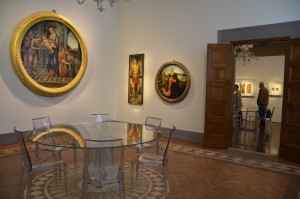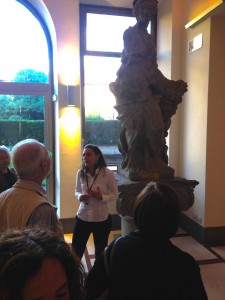
Ente Cassa di Risparmio di Firenze.
Dal 1 ottobre 2016 al 15 gennaio 2017, prorogata fino al 26 febbraio
Di Maria Eletta Benedetti (Università degli Studi di Firenze)
La bellissima vetrata d’ingresso dell’antica residenza della famiglia Pucci, divenuta la sede della Fondazione Cassa di Risparmio di Firenze, viene aperta come uno scrigno al pubblico per gustare un percorso d’arte che va dal XIII al XX secolo, come suggerisce il sottotitolo della mostra.
Il percorso espositivo curato da Carlo Sisi, è un percorso sui generis. Non vi è un consueto o innovativo allestimento, non è predisposta un’apposita illuminazione né ci sono pannelli espositivi o didascalie: “solo” opere, giovani guide e sale d’ufficio. La particolarità e l’eccezionalità della mostra “In collezione” infatti è proprio quella di essere sistemata negli ambienti che quotidianamente ospitano le attività bancarie della Fondazione e per questo motivo la mostra è visitabile gratuitamente solo nei giorni festivi su prenotazione. Vengono esposte le opere più belle che l’Ente cassa ha collezionato principalmente nel corso del Novecento. Il percorso non segue un ordine cronologico sia perché la mostra è dislocata nei vari ambienti d’ufficio e forse non sarebbe stata una scelta molto funzionale né efficace; sia perché rende ancora più evidente l’intento della mostra, che non è didattico (disponendo le opere dalla più antica alla più recenti possedute dall’Ente Cassa) e nemmeno narrativo della storia collezionistica (quindi posizionando le opere in ordine di acquisizione).
Lo scopo è quello di “mostrare”, di rendere fruibili opere rare e di grande valore, di entrare appunto dentro una collezione. Di per sé il semplice “mostrarsi” della collezione, come un’eco di un’antica camera delle meraviglie può apparire anacronistico o mera ostentazione, tuttavia è risultato estremamente affascinante e formativo. Nel primo caso perché ogni stanza d’ufficio è una piccola scoperta e una sorpresa, con la possibilità di osservare e gustare opere preziose. Formativo grazie al ruolo delle guide e all’accordo evidente tra vari fattori quali il contenuto e i valori trasmessi dalle opere, la relazione tra le opere possedute dalla Fondazione e la relazione con il territorio e infine la scelta di esporre semplicemente le opere alle pareti negli ambienti lavorativi e di rappresentanza.
Dopo una introduzione sulla nascita della Fondazione al piano terra la guida accompagna i gruppi di visitatori al piano superiore, accolti dapprima da tre ritratti, in particolare quello di Lord Cowper realizzato da Mengs, una delle più recenti acquisizioni. Si accede successivamente ai vari uffici, da quello del Presidente della Fondazione con appese alle pareti varie vedute di Firenze tra Settecento e Ottocento, alle Sale riunioni e d’attesa, passando dalle grandi tele dei Macchiaioli alle tavole di Giotto. Del maestro trecentesco l’Ente possiede due preziosi frammenti tanto piccoli da suggerire allo studioso Bellosi l’associazione con la forma delle fette biscottate. Come per contrasto è stupefacente il grandissimo tondo di Filippino Lippi; intrigante è la sala d’attesa con la serie delle Vedute di Firenze antica di Borbottoni. In un’altra stanza di rappresentanza campeggia il grande encausto a freddo di Colacicchi che un tempo decorava lo storico caffè fiorentino Gambrinus.
Le opere non sono quindi una ricchezza solo dell’Ente Cassa che possiede la collezione ma anche del territorio perché a questo sono strettamente legate tramite le provenienze e tramite le raffigurazioni di spaccati di città o di santi a cui Firenze è devota, realizzati da artisti eterogenei nello stile e nei secoli. Ogni stanza racconta un pezzetto di storia dell’arte toscana, in particolare quella fiorentina.
A rendere tutto ancora più singolare è la possibilità di vedere, come in una matrioska, opere di una collezione all’interno di uffici dislocati e adibiti a questa funzione in un’opera d’arte architettonica. L’edificio infatti è stata riorganizzato negli anni Cinquanta del Novecento da Michelucci e percorrendo la sua grande scalinata termina il percorso della mostra “In collezione”. Il luogo è un ulteriore collante tra le opere e lo scopo della mostra, perché viene data la possibilità di mostrare un’opera d’arte e di percorrerla rispettando quindi il carattere peculiare di una creazione architettonica che è appunto quello di essere praticabile, come lo è quotidianamente dal personale della Fondazione.
Il percorso espositivo è strutturato ad anello. Attiguamente alla sala d’accesso, che funge anche da uscita, è interessante lo spazio predisposto come sala multimediale, in cui è stata predisposta una camera immersiva per mostrare attraverso un filmato sia le opere esposte sia alcune conservate nei depositi. Il video viene proiettato in sette schermi verticali disposti a semicerchio con una musica dolce di violino e flauto in uno spazio completamente buio. Qui le opere prendono vita, sollecitando l’immaginazione e il desiderio di tornare un po’ bambini. Un invito a guardare le opere con uno sguardo innocente, puro e fantasioso aiutati dall’animazione multimediale, perché nel video gli scialli contadini raffigurati dai macchiaioli si sollevano al soffio del vento, i carri e i personaggi delle vedute si muovono in una Firenze fuori dal tempo che non esiste più, gli angeli cantano e i garibaldini combattono la loro battaglia. Si vede la vita dietro al quadro in un accenno di movimento per tornare poi di nuovo disegno, un dettaglio e una storia fermata sulla tela. Un invito ad entrare oltre che “in collezione” anche “in opera”, come suggerisce per l’appunto la videoinstallazione.
Nella mostra l’arte si diffonde nell’ambiente e si fonde con esso, non già musealizzata o messa in vetrina ma collocata nella quotidianità di un luogo di lavoro. Essenziali ad aiutare la scoperta e la conoscenza delle opere, degli artisti e della Fondazione, sono le guide, che danno voce alla collezione.

Translation by Rachyl Grussing
The beautiful glass entrance to the old residence of the Pucci family, which became the headquarters of the Fondazione Cassa di Risparmio di Firenze, opens as a casket to the public to enjoy a journey through art that goes from the thirteenth through the twentieth centuries, which is the subtitle of the exhibition.
The exhibition is curated by Carlo Sisi, and is a path sui generis. There is no usual or innovative option, there is not any special lighting, neither are there exhibition panels or captions: there are ‘single’ works, young guides. and office rooms. In fact, the particularity and uniqueness of the exhibition ‘in the collection’ is precisely the display in the environments that are home to the bank’s daily activities, and for this reason the show is only available on holidays by appointment. Exhibited are the most beautiful works that the Foundation has collected over the course of the 19th century. The path does not follow chronological order because the exhibition is located in various office spaces and perhaps would not be a very practical nor effective choice; it also makes even more evident the intentions of the show, which are not teaching (by placing the oldest to the most recent works collected by the Foundation) and not telling the story of the collection (by placing the works in order of acquisition).
The purpose is to ‘show’, to render available, the rare works and the works of great value, to simply enter inside the collection. For itself, the simple ‘showing’ of the collection, like an echo of an ancient chamber of wonders, can appear anachronistic or merely ostentatious, however the result here is extremely fascinating and formative. Each office room is a small discovery and surprise, with the possibility to observe and enjoy precious works; thanks to the role of the guides, clear agreement between the various factors, content, and values transmitted by the works, the relationship between the Foundation and the relationship with the territory, and finally the choice of exposing the works on the walls of the environments which they represent.
After an introduction to the birth of the Foundation on the ground floor, a guide accompanies the group of visitors to the upper floors. Initially they are greeted by three paintings, notably that of Lord Cowper, made by Mengs, one of the most recent acquisitions. The tour then enters the various offices, from that of the President of the Foundation with wall-hangings of the various views of Florence from the 17th and 18th centuries, to the Meeting and Waiting room, passing the large canvases of Macchiaioli and the table of Giotto. The fourteenth century master of the body has two precious fragments so small suggesting he studied under Bellosi, with the association with the shape of biscuits. For amazing contrast is the great round painting of Filippino Lippi; intriguing is the waiting room with the series Views of Ancient Florence by Borbottoni. In another room stands the representation of the encaustic and cold Colacicchi that at one time adorned the historic Florentine Cafe Gambrinus.
The works are not only the wealth of the Foundation, who own the collection, but also the territory, because they are closely linked with the origins, through the depictions of different cities and saints that Florence worshipped, made my heterogenous artisans in the style of the century. Every room contains a priceless piece of the history of Tuscany, in particular that of Florence.
To make it even more unique is the possibility to see everything, like in a Russian doll, the works of the collections in the offices displayed and used in this function operate as architectural art. In fact the building was reorganized in the 1950s by Michelucci and travelling along the grand staircase is the route of the show ‘in collection’. The site is a further bond between the works and the purpose of the show, because it is given the possibility to show a work of art and follow it, thus retaining the particular character of the architectural creation that is intended to be workable, as it is every day from the personnel of the Foundation.
Adjoining the hall of access, which also acts as an exit, it is interesting space dedicated to multimedia, an immersive film was prepared to show both the works on display and some kept in storage. The video is projected in six vertical screens displayed in a semicircle, with sweet violin and flute music in a completely dark space. Here the works come to life, urging the imagination and desire to return to that of a small child. It is an invitation to see the works with an innocent look, helped with the pure and fantastic multimedia animation, because in the video the shawls of the farmers from Macchiaioli are raised by the blowing of the wind, the wagons and views of the people move in a Florence out of a time that no longer exists, the angels sing and the partisans fight their battle. You see the life behind the picture in a hint of drawn movement, and return again to a detail of the history which stops of the canvas. An invitation to enter ‘in collection’ as well as ‘in work’, precisely as suggested by the video installation.
In this exhibition the art spreads into the environment and merges with it, not in a museum or on display, but placed in the everyday life of a workplace. Essential to helping with the discovery of the works are the artists of the Foundation, the ones with all the knowledge of the artworks, who are the voice of the collection.